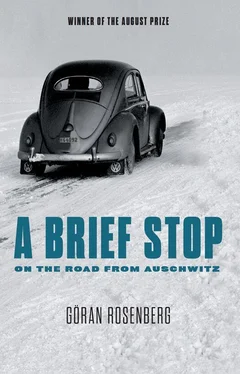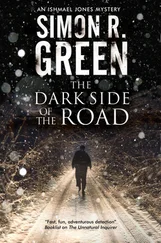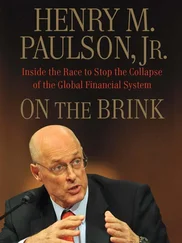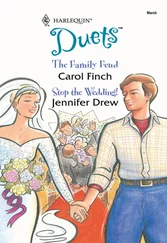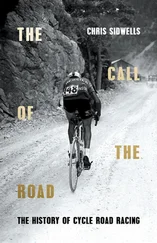In the course of ten weeks, at an accelerating rate, more than a thousand of the five thousand prisoners in Wöbbelin die. At the beginning of April, some forty are dying every day, but by the end of the month, when you arrive, between eighty and a hundred. A few more unliberated days and the camp would have fulfilled its mission. Until the middle of April, the corpses are dumped into newly dug mass graves in the sandy heathland beyond the forest, a few kilometers from the camp and not far from the railroad track that links Wöbbelin to the rest of the disintegrating camp archipelago. It happens that living bodies are thrown into the mass graves as well. In the piles of dead bodies, one or two are still breathing.
“Living skeletons were scattered about, the dead distinguishable from the living only by the blue-black color of their skin,” writes James M. Gavin.
Another difference between the living and the dead is that the living sometimes eat the dead. Not that there’s much on the dead worth eating, but cannibalism in Wöbbelin is a known and certified fact. Toward the end of April, there are too many bodies to be moved to the mass graves, so they’re piled up in one of the barracks instead. In a photograph taken at the liberation, most of the dead are lying naked, or rather, stripped of their clothing. In another photograph, the living are wearing double layers. Yet another difference between the living and the dead in Wöbbelin.
For you, the difference between life and death is the food parcels.
The food parcels and the timing.
At the time of your arrival, liberation is a week away.
You need only to survive a week in Wöbbelin to survive the war.
I’m not sure you would have survived a week in Wöbbelin without the food parcels.
To my knowledge, the transport from Ravensbrück to Wöbbelin is the only transport in disintegrating Germany where prisoners en route to their planned disappearance eat corned beef and smoke Camel cigarettes on the train. I learn of comparable transports on which the prisoners drop like flies and are buried here and there along the embankments, for example in the town of Sülsdorf on the railroad line a few dozen kilometers north of Wöbbelin, where 217 women and 129 men in transit from Aussenlager Beendorf are buried; those who survive all the way to Wöbbelin aren’t in much better shape. Death in Wöbbelin is continuously reinforced with the dying delivered by the transports.
The food parcels are and remain a mystery to me. If you’re not bound for Sweden to survive but for Wöbbelin to disappear, why the parcels? Is the whole thing just a grotesque joke? The Nazis specialize in grotesque jokes. In euphemisms and grotesque jokes. Why aren’t the food parcels confiscated? How are you able to hang on to your food parcels in a camp where the living are eating the dead?
I find it hard to visualize you with a food parcel in Wöbbelin, but as you know, there’s a great deal I find hard to visualize.
You write that it’s the food parcels that save you in Wöbbelin, particularly the cigarettes. You write in your letter to the woman who is to be my mother that you have two hundred American cigarettes in Wöbbelin, and you make it sound like a small fortune. Clearly, you don’t want to give her the impression that you’ve had a particularly hard time on your road from Auschwitz: “As you can see from what I tell you, things weren’t all that terrible. I somehow sense that you’ve been through worse.”
This is what you sense, since she’s not telling you anything about her road from Auschwitz. Letter after letter, and she tells you nothing. Your sense is that someone who doesn’t tell has something unspeakable to hide. The fact that she doesn’t tell fills you with anxiety. I believe that you tell in order to make her tell. But think of it, how much do you actually tell her? Almost nothing about your days in Wöbbelin. In Wöbbelin “they had it in for us” is as far as you go in terms of detail. You write about the leaky huts and the “terrible” hunger, but say nothing of the living dead.
It suddenly dawns on me what you mean by the verb “to bore.” To bore is to tell someone something you don’t want to burden her with. To bore. To speak of the unbearable.
So you tell what’s bearable to tell. The liberation, for example. On May 1, 1945, the Americans are on the outskirts of Ludwigslust and the Germans make one last attempt to follow Himmler’s orders. In the afternoon you’re ordered to board yet another train of open freight cars. A hundred and thirty of you to a car, you write. You also write that you all knew what was at stake:
If that train reached its destination, we’d had it. We stood in the cars all night. On the morning of May 2, we heard the guards telling each other the Führer was dead. At ten o’clock they hustled us back to the camp, and at twelve we were free. I just can’t say any more about all this, but when we meet again, which will be soon, we’ll have lots to tell each other.
That’s all you write to the woman who is to be my mother.
You don’t write about things no one’s going to understand anyway.
You don’t write about the unbearable.
The day after the liberation of Wöbbelin, the local population is ordered to view the camp. There’s a photographic record of this event. A young woman with a coat and handbag is looking in horror at the dead bodies on the ground and has put one hand to her heart; another holds her hand to her mouth and stares at the camera, eyes open wide; an elderly man with a stick and a peaked cap looks doggedly straight ahead. Wherever they direct their gaze, the dead stare back at them. Hundreds of dead people. Piles of dead people. The 3,500 prisoners still alive at Wöbbelin stare back at the townspeople too. Many of the surviving prisoners are incapable of moving from the spot, let alone taking their revenge on the well-nourished and well-dressed people filing past them. One or two get their hands on a well-dressed local’s jacket or coat, but that’s all. Some try to welcome their liberators with cheers and national anthems, but most lack the energy. Many die during the liberation and many more after the liberation; those still alive are cared for in a makeshift hospital in an aircraft hangar on the edge of Ludwigslust and, once the hangar is full, in one of the permanent hospitals and nursing homes in the town and surrounding area. “The comfortable bed in the little palace in the town of Ludwigslust” is how you describe the hospital or nursing home where you’re treated for typhus over the course of several weeks before continuing your journey.
Wöbbelin isn’t the end of your road from Auschwitz.

In Wöbbelin there’s not much for the previous night’s newly fallen snow to conceal; all traces of the former camp have been erased long since. Only a memorial stone of unhewn granite at the side of road 106 from Ludwigslust and an information board with a map on the edge of a sparse copse of birches mark the location of the camp. I suspect the birches date from the liberation, and I’m amazed at how small an area it is, maybe thirteen or fourteen acres in all, and how easy it is to expunge the traces of hell, and how close it actually is to the mass graves. The graves too have been taken over by trees, a meager wood of young pines, and the only thing to mark what’s hidden beneath them is an engraved memorial plaque on a flat slab of stone on the edge of the wood. I clear away the four-inch layer of snow that has covered the inscription like a blank page and read:
Here lie the victims of a camp that was situated just a few hundred meters east of this spot. They died of starvation, illness and brutal mistreatment. We do not know their names but we shall never forget them.
Читать дальше
